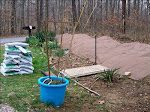1. Cut the bottom out of a garbage can.
2. Mount wire mesh across two pieces of wood to create a screen raised slightly off the ground.
3. Upend the garbage can onto the screen.
4. Cover the screen with a thick layer of newspaper.
5. Spread a thin layer of kitchen waste on the newspaper.
6. Mound a layer of dry leaves and dirt on top of that.
7. Sprinkle with worm casings
8. Make a second layer of kitchen waste.
9. Cover with soil and dry leaves. You can also use dry grass cuttings from your yard.
Keep the compost loose.
Never add anything harmful to your compost. Some shrubbery is poisonous so don’t add anything except grass cuttings to your compost. Don’t use meat or meat juice. Shrimp shells are good. Eggshells are good. I do not use manure in my compost because I don’t have access.
If possible, grind up or chop up whatever you add to compost. This step creates more work for you in the beginning, but the end results are well worth it.
Boosts
Worms
Instead of using animal manure in your compost, try using worm castings, a super boost. Follow directions for making worm casting tea.
Leaves
Every fall I beg for leaves. I keep some of the leaves in bags to add to the compost. The rest I spread liberally in a thick layer on my garden beds. I tarp them down with landscape cloth that allows the rain to filter through. By planting time the leaves having decomposed enough to be turned into the soil.
Grass
During grass-cutting season, we let the grass on the back half of our land grow long. When it is cut, I let it lie in the sun until dried out before raking up to use in compost. Grass acts a green manure in your compost, eliminating the need to use animal wastes.
Beer
You can add a half bottle of beer per 2 bushels. The beer contains yeast which will ferment.
Charcoal
We have an outdoor fire pit. I dump the cold ash and charcoal directly into the compost. Be SURE you allow ample time for the ash/charcoal to cool.
Blood Meal
If you use blood meal, remember it is high in nitrogen and can burn your plants. It will speed the breakdown process in your compost. Be advised that blood meal is a slaughterhouse by product.
Herbs for the garden
Comfrey tea is a wonderful addition to compost. After making poultices and tinctures, always bless the herb and put it into the compost to go back to the earth.
Bone Meal
Adds phosphorus to the soil and can be used liberally. Sprinkle on compost.
Epsom Salts
Add magnesium to the soil.
Endgame
At the end of one month, I lift the garbage can off the compost pile and cover the pile with a tarp. Once a week I uncover the heap, stir the compost, then wet it down and re-tarp. I use a tarp so that rain doesn’t wash out all the nitrogen in the pile. With care and boosting, you can produce good compost in 3 months. Just in time for spring planting.















